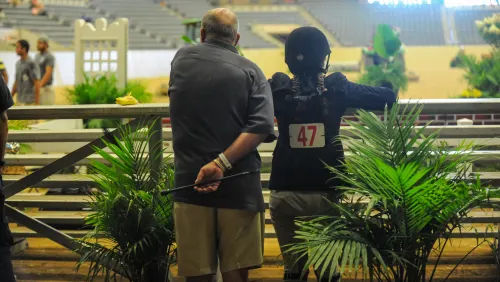It’s time for us horsemen and horsewomen to work with show managers.
We exhibitors have got to stop treating the show managers as the enemy–and the show managers have got to stop treating the exhibitors as a pain in their horse show!
I sit on now or have served on many U.S. Equestrian Federation committees, and I’m constantly seeing rules proposed to control the poor behavior of certain individuals who are bending or even breaking the existing rules. It’s long past the time to start passing rules for the good of the horse, not just to keep a few bad apples from souring everything.
Many of you are aware that there was a tragic accident at the Washington (D.C.) International Horse Show last month. My friend Scot Evans is a trainer, judge and a well-educated, compassionate horseman, and he was doing some flatwork with his owner’s horse during a time period in which 60 horses were allowed in the schooling ring at once. Yes, 60 children’s and adult jumpers in too small a space! A horse kicked the horse Scot was riding and broke the horse’s leg, and he was put to sleep on the spot. Sadly, this was an accident that didn’t need to happen.
The Pennsylvania National in Harrisburg holds the USEF Medal Finals and other national finals, and it has the same potential for the kind of devastating accident that occurred at Washington.
Really, almost every show that’s put on in this country has this problem, and all of us have to address it in a safe and intelligent manner. We cannot continue to allow this dangerous system we’ve created to continue.
It’s time to control the schooling of riders and horses, particularly at indoor shows that host our national finals.
Riders, trainers and horses have worked all year to qualify for these shows. They’re not the shows you decide to go to a month, a week or a day before the show starts. They all have qualifying criteria and deadlines for entering.
ADVERTISEMENT
The Harrisburg management said earlier this year that they were going to try to control things by monitoring the horses competing in the USEF Medal. They were going to have the equitation horses stabled in one area, much like the jumpers competing in FEI-sanctioned classes. Every horse would have to wear a number when out of his stall for any reason. But the show management caved in and allowed business as usual when the trainers who abuse schooling at these shows pressured them.
At the Syracuse Invitational (N.Y.) this month, management gave you certain hours for longeing and certain hours for riding–other than that your horse wasn’t allowed out of the stall. It ran very well.
At the Quarter Horse Congress, where thousands of horses compete, you have to sign up and pay for a 10-minute schooling session with five other people. They say it works great. Maybe it’s time for our shows to implement something like this.
If we continue to allow 60 people or more to school in a confined area in a short time frame, we’re simply going to have more of these tragic accidents.
Even worse, some trainers at these indoor finals like to set a course of garbage cans and various dangerous obstacles that you’d never jump in the ring at a show–and they do it at all hours of the night. It’s ridiculous. The emergency medical technicians and veterinarians aren’t there all night.
Luckily, when Scot’s horse got kicked at Washington, the veterinarians were there because it happened in the morning. There was also a horse ambulance on site.
If you’re a trainer or rider who qualifies for one of these national finals and you have to jump courses of strange obstacles all night long to be ready for the class, you shouldn’t be there. Do your homework at home!
I have never seen our top professional riders jumping courses in the middle of the night before an FEI World Cup Final, before the Olympics, or before a big-money grand prix. Why? Because they do their homework before they go to the show.
ADVERTISEMENT
Let’s see the juniors and their trainers longe, do flatwork and jump the four jumps set in the schooling area by management–in the correct direction–and go in the ring. Maybe we wouldn’t see so many rails down and the poor jumping by exhausted horses we’ve seen over the past five years if they did it the right way.
Let’s start to teach our juniors good horsemanship. Let’s show them how to get their horses and themselves ready without the ridiculous behavior that’s going on.
At the Ronnie Mutch Equitation Class in Wellington (Fla.) each winter, schooling is part of the judging criteria. A top horseman scores the quality, or lack of quality, in each junior rider’s preparation for the class. On more than one occasion the schooling and the juniors’ manners have made the difference between ribbons.
I never saw the professionals during senior week at Harrisburg dragging their own jumps and garbage cans into the schooling area and riding all night long. And their horses were turned out beautifully; they school with a plan and have shining boots and clean tack!
But too many junior riders are too tired to shine their boots, clean their tack, or put a smile on their face. Maybe if their trainers weren’t focusing on jumping all night, they could think about other important details.
I can assure you that the Zone 2 teams that won the North American Young Riders Championships in Chicago this summer and that won the Prix de States in Harrisburg in October didn’t stay up all night to win the gold. And I know our Olympic team didn’t stay up all night jumping bizarre obstacles.
So let’s get together and rethink our horsemanship, our future, and the best situation for our equine friends.














